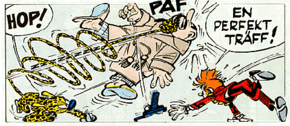Marcinelle school
The term "Marcinelle school" (French: École de Marcinelle) or "Charleroi school" (École de Charleroi) refers to a group of Belgian cartoonists formed by Joseph Gillain (known as Jijé) following World War II. ("Bande à quatre", "Gang of four", also consisting of Franquin, Morris and Will.) Marcinelle school cartoonists were all associated with the weekly magazine, Spirou, whose offices in the 1940s were located in the town of Marcinelle, near Charleroi in Belgium.

The style of these cartoonists soon became the preferred in-house style for artists working at the influential Spirou magazine, and thus had a huge impact on the Belgian comics and Franco-Belgian comics scene, inspiring generations of cartoonists. [1]
Style
Stylistically, the Marcinelle school is a mix of cartoonish and realist, and is also sometimes called comic-dynamic ("comic" here refers to "comical", not the medium). It is often cited in books in opposition to Hergé's ligne claire style. Though these two styles have much in common, Marcinelle school is all about conveying the impression of movement, while ligne claire tends to be more schematic.
List of artists
The artists most closely associated to the Marcinelle school are:
- Joseph Gillain (Jijé)
- André Franquin
- Maurice de Bevere (Morris)
- Willy Maltaite (Will)
- Eddy Paape
- Pierre Culliford (Peyo)
- Jean Roba
- Victor Hubinon
Other artists considered part of the School include:
- Jean de Mesmaeker (Jidéhem)
- Paul Deliège
- Pierre Seron
- Sirius
- Maurice Tillieux
- François Walthéry
- Marc Wasterlain